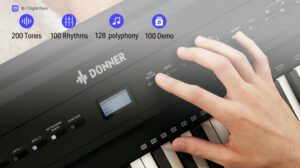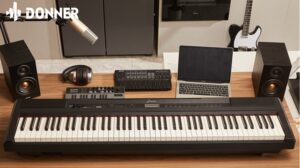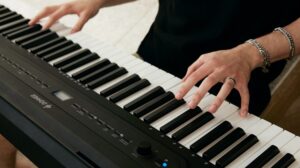When it comes to choosing between the Donner SE-1 and the DEP-20 digital pianos, it’s important to understand what each piano offers to determine which one is the better fit for your musical needs. In this comparison, we’ll delve into the features and qualities of both pianos, so you can make an informed decision.
Keyboard Feel
The Donner SE-1 boasts a fully weighted 88-key keyboard with hammer action. This feature provides a remarkably authentic feel when playing, closely simulating the touch of an acoustic piano. Furthermore, the keys are velocity-sensitive, meaning they respond dynamically to your playing style. In contrast, the DEP-20 offers a scaled hammer action keyboard, which mimics the weight of hammers in a grand piano but doesn’t replicate the same resistance as an acoustic piano. While the DEP-20 also has touch sensitivity, some users find that the keys are slightly less responsive compared to the SE-1. Overall, both digital pianos offer a satisfying playing experience, but the SE-1’s fully weighted hammer action keyboard might provide a more authentic feel, particularly for advanced players or those aiming to recreate the acoustic piano experience.
Tone
In terms of tone, the Donner SE-1 offers a rich and realistic sound with its 88-key fully weighted hammer action keyboard and adjustable touch response. The SE-1 features 238 tones, including various types of grand pianos, electric pianos, organs, and more. These piano sounds are meticulously sampled from high-quality acoustic pianos, resulting in a nuanced and authentic sound. On the other hand, the DEP-20 produces a slightly brighter tone compared to the SE-1 but provides more sound versatility. With 128 polyphony and 20 voices, including different piano types, electric pianos, organs, harpsichords, and more, the DEP-20 offers a broader range of sonic options. Additionally, it features effects like reverb, chorus, and EQ, allowing for further sound customization.
Sound System
Both the Donner SE-1 and DEP-20 come equipped with built-in speakers, eliminating the need for external amplification. However, there are differences in their sound systems. The SE-1 boasts a robust 40-watt, 4-speaker sound system that delivers a clear and powerful sound. The placement of the four speakers across the instrument creates a wider and more immersive sound field, resulting in well-balanced tones with crisp highs, rich mids, and deep lows. In contrast, the DEP-20 features a 30-watt, 2-speaker sound system with both speakers positioned in the same location. While the DEP-20 still delivers good sound quality with a balanced tone and clarity, it may offer a slightly less immersive sound experience. Overall, both instruments produce realistic and pleasant piano sounds, with the SE-1 having a slightly richer and more nuanced tone. However, the SE-1’s sound system is more potent and versatile, providing a more immersive and enjoyable playing experience.
Features
The Donner SE-1 adopts a minimalistic design with a straightforward interface, emphasizing a realistic piano sound with its 88 hammer-action keys. The SE-1 offers three piano tones—Grand Piano, Upright Piano, and Electric Piano—and boasts 128-note polyphony. Nevertheless, the SE-1 lacks certain advanced features compared to the DEP-20. It does not have a split mode, which allows players to utilize different sounds on various parts of the keyboard. Moreover, it lacks built-in accompaniment features or the capacity to record and save performances. Nevertheless, the SE-1 does feature MIDI connectivity and a USB port, facilitating connections to external devices and recording software.

In contrast, the Donner DEP-20 offers an extensive range of features. It features 128 polyphony and 238 tones, including various acoustic and electric pianos, organs, strings, and more. The DEP-20 also incorporates 100 built-in accompaniment styles, which can be invaluable for beginners looking to practice alongside a band or orchestra. The split mode, present in the DEP-20, allows players to use two different sounds on separate parts of the keyboard. Additionally, the DEP-20 includes a recorder for capturing and saving performances directly on the instrument. With Bluetooth connectivity, it enables wireless connections to external devices.

Portability
In terms of portability, the SE-1 has the edge. Weighing in at just 14.6 kg and featuring a slim design, it is lighter and more compact than the DEP-20 (15.4 kg). This makes the SE-1 a convenient option for those who need to move their piano frequently or have limited space.
Conclusion
In conclusion, the Donner SE-1 digital piano excels in providing a high-quality piano-playing experience within a compact and affordable package. Its realistic feel and exquisite sound are sure to satisfy even the most discerning piano players. While the DEP-20 offers greater versatility and features, the SE-1’s focus on delivering an authentic piano experience sets it apart. Ultimately, your choice between the SE-1 and DEP-20 depends on your priorities and needs as a pianist. If you value a genuine piano feel and sound, the SE-1 is a top contender. However, if you require a versatile digital piano for experimentation with various voices and playing modes, the DEP-20 might be the better choice.

